Nursing Assignment: Cultural Safety Position Statement Analysis
VerifiedAdded on 2022/11/13
|10
|2751
|437
Report
AI Summary
This nursing assignment analyzes a position statement on cultural safety in healthcare, focusing on the Australian Indigenous Doctors’ Association's role in improving health outcomes for Aboriginal and Torres Strait Islander communities. The report examines the definition of cultural safety, emphasizing the importance of effective communication and health literacy in addressing discrimination and promoting mental well-being. It highlights the organization's strategies, rationale, and collaboration with other healthcare bodies to minimize barriers and advocate for the rights of indigenous populations. The assignment also discusses the barriers to implementing the position statement, such as lack of education and employment, and the importance of ethical values. The conclusion emphasizes the vulnerability of indigenous populations and the role of cultural safety in combating discrimination, promoting equality, and improving overall health outcomes through various initiatives and collaborations.
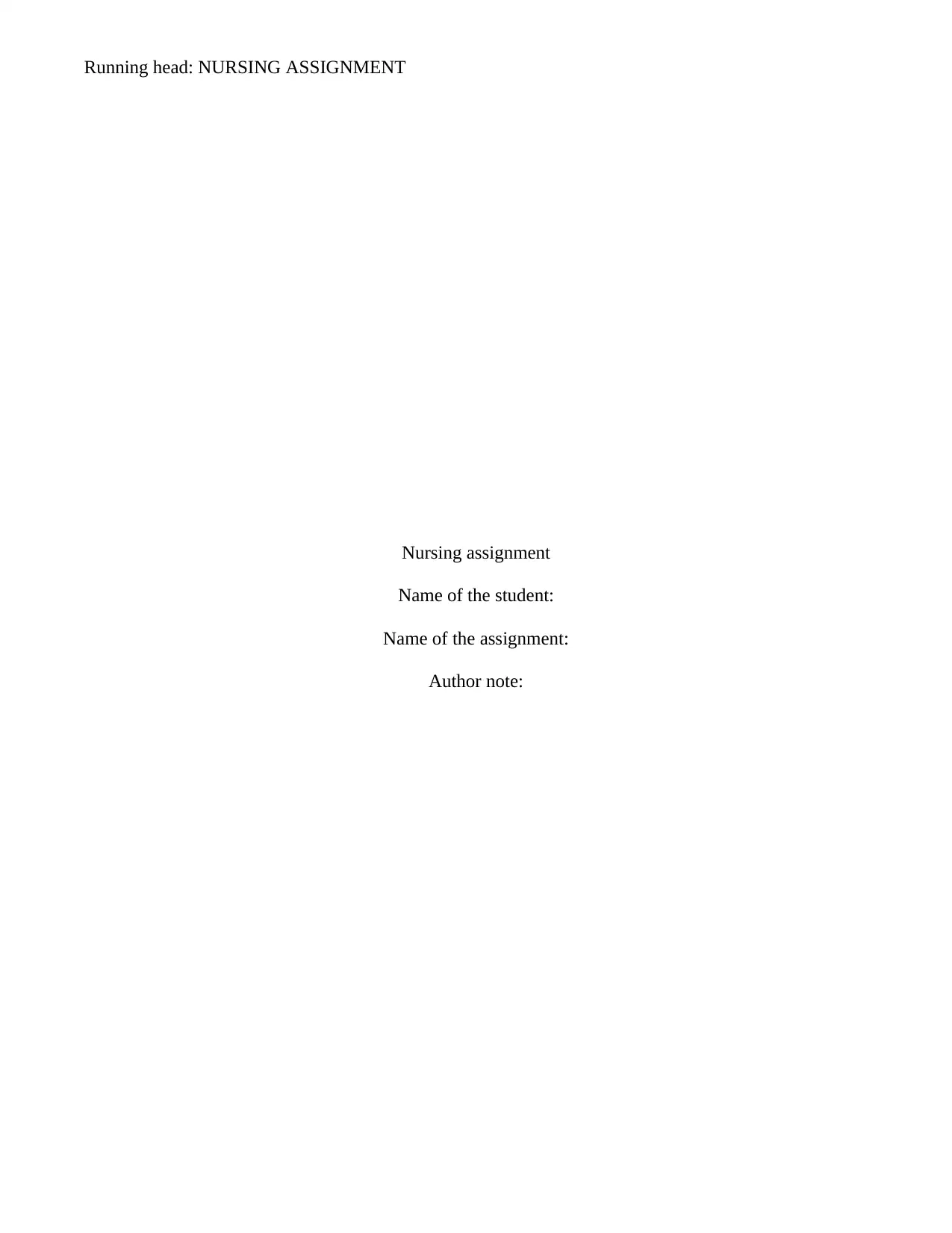
Running head: NURSING ASSIGNMENT
Nursing assignment
Name of the student:
Name of the assignment:
Author note:
Nursing assignment
Name of the student:
Name of the assignment:
Author note:
Paraphrase This Document
Need a fresh take? Get an instant paraphrase of this document with our AI Paraphraser

1Nursing Assignment
Background/ introduction:
Cultural safety is defined as application and accumulation of knowledge of the local population
such as Aboriginal and Torres Strait Islander. The cultural safety deals with principles, norms and values
of the community (Pauly, McCall, Browne, Parker & Mollison, 2015). In the position paper, the
communication and interaction used in providing cultural safety to the local population is evaluated. In
Australia, the Aboriginal and Torres Strait Islander requires cultural safety to lead a healthy and
respectful life within the community and hence requires cultural safety. Cultural safety involves
healthcare professionals to examine their own believes, practices ad behaviors (Laverty, McDermott, &
Calma, 2017). Along with the practice, racism and other discrimination has been evaluated. The main of
providing cultural safety is to improve their standard of light as well to provide a stable platform for
them, where they get equal opportunities and respect without facing any decimation based on race, caste
or religious background (Antonsen, 2017). Aboriginal individual have poor health outcomes as
compared with the other communities. The rate of mental illness is maximum in case of Aboriginal and
Torres Strait Islander. Due to the discrimination they face, they went into depression or severe mental
illness. In order to minimise the number of people affected with mental illness or physical disease, some
health care organization works to provide them cultural safety (Baba, Brolan & Hill, 2014). One of such
organization is The Australian Indigenous Doctors’ Association (AIDA). It works to provide cultural
safety to the individual suffering from discrimination based on their race and background. According to
Australian Indigenous Doctors’ Association (AIDA), continuous care with respect to cultural awareness
is one of the most important learning in proving cultural safety to the patient or to the minority
population. The next step initiated by the Australian Indigenous Doctors’ Association, where the self-
exploration occurs. It is the second step which involves the cultural sensitivity. The cultural safety is
Background/ introduction:
Cultural safety is defined as application and accumulation of knowledge of the local population
such as Aboriginal and Torres Strait Islander. The cultural safety deals with principles, norms and values
of the community (Pauly, McCall, Browne, Parker & Mollison, 2015). In the position paper, the
communication and interaction used in providing cultural safety to the local population is evaluated. In
Australia, the Aboriginal and Torres Strait Islander requires cultural safety to lead a healthy and
respectful life within the community and hence requires cultural safety. Cultural safety involves
healthcare professionals to examine their own believes, practices ad behaviors (Laverty, McDermott, &
Calma, 2017). Along with the practice, racism and other discrimination has been evaluated. The main of
providing cultural safety is to improve their standard of light as well to provide a stable platform for
them, where they get equal opportunities and respect without facing any decimation based on race, caste
or religious background (Antonsen, 2017). Aboriginal individual have poor health outcomes as
compared with the other communities. The rate of mental illness is maximum in case of Aboriginal and
Torres Strait Islander. Due to the discrimination they face, they went into depression or severe mental
illness. In order to minimise the number of people affected with mental illness or physical disease, some
health care organization works to provide them cultural safety (Baba, Brolan & Hill, 2014). One of such
organization is The Australian Indigenous Doctors’ Association (AIDA). It works to provide cultural
safety to the individual suffering from discrimination based on their race and background. According to
Australian Indigenous Doctors’ Association (AIDA), continuous care with respect to cultural awareness
is one of the most important learning in proving cultural safety to the patient or to the minority
population. The next step initiated by the Australian Indigenous Doctors’ Association, where the self-
exploration occurs. It is the second step which involves the cultural sensitivity. The cultural safety is

2Nursing Assignment
regarded as the final outcome of the steps or the process. It is multi-dynamic process where the place of
the population from local community facing safety issue based on their race can be changed by the
setting of the community. Australian Indigenous Doctors’ Association code of conduct and values
involves cultural safety and also is considered as the key principle of the collaboration agreement of
Australian Indigenous Doctors’ Association. The main purpose of Australian Indigenous Doctors’
Association is to enhance cultural safety among the individuals who are from another countries either
for work and studies or permanently settled there. The indigenous population of Australia are more
likely to suffer from such discrimination in their daily life and hence requires cultural safety (Green &
Minchin, 2014). Australian Indigenous Doctors’ Association is considered as the peak organization in
the field of healthcare. Australian Indigenous Doctors’ Association aims to strongly position to those
areas that lacks cultural safety for the indigenous population. Australian Indigenous Doctors’
Association develops certain strategies which is useful in providing cultural safety to the local
population. It aims to reduce the cultural differences between different races and ensures that the minor
population gets equal respect as compared to the other individual (AIDA.ORG, 2019).
Position statement:
The term position statement is defined as the “a range of evidenced-based statements to
communicate an organisation’s position on key issues of relevance to achieving a healthy Australia,
supported by the best possible healthcare system”.
Australian Indigenous Doctors’ Association holds strong position in order to ensure cultural safety to
the individual who belongs to indigenous population or minor community. It advocates strongly in order
to enhance the strength and respect of the minor communities in the society (Young-Hyman et al.,
2016). It provides cultural safety to the population through (AIDA.ORG, 2019).
regarded as the final outcome of the steps or the process. It is multi-dynamic process where the place of
the population from local community facing safety issue based on their race can be changed by the
setting of the community. Australian Indigenous Doctors’ Association code of conduct and values
involves cultural safety and also is considered as the key principle of the collaboration agreement of
Australian Indigenous Doctors’ Association. The main purpose of Australian Indigenous Doctors’
Association is to enhance cultural safety among the individuals who are from another countries either
for work and studies or permanently settled there. The indigenous population of Australia are more
likely to suffer from such discrimination in their daily life and hence requires cultural safety (Green &
Minchin, 2014). Australian Indigenous Doctors’ Association is considered as the peak organization in
the field of healthcare. Australian Indigenous Doctors’ Association aims to strongly position to those
areas that lacks cultural safety for the indigenous population. Australian Indigenous Doctors’
Association develops certain strategies which is useful in providing cultural safety to the local
population. It aims to reduce the cultural differences between different races and ensures that the minor
population gets equal respect as compared to the other individual (AIDA.ORG, 2019).
Position statement:
The term position statement is defined as the “a range of evidenced-based statements to
communicate an organisation’s position on key issues of relevance to achieving a healthy Australia,
supported by the best possible healthcare system”.
Australian Indigenous Doctors’ Association holds strong position in order to ensure cultural safety to
the individual who belongs to indigenous population or minor community. It advocates strongly in order
to enhance the strength and respect of the minor communities in the society (Young-Hyman et al.,
2016). It provides cultural safety to the population through (AIDA.ORG, 2019).
⊘ This is a preview!⊘
Do you want full access?
Subscribe today to unlock all pages.

Trusted by 1+ million students worldwide
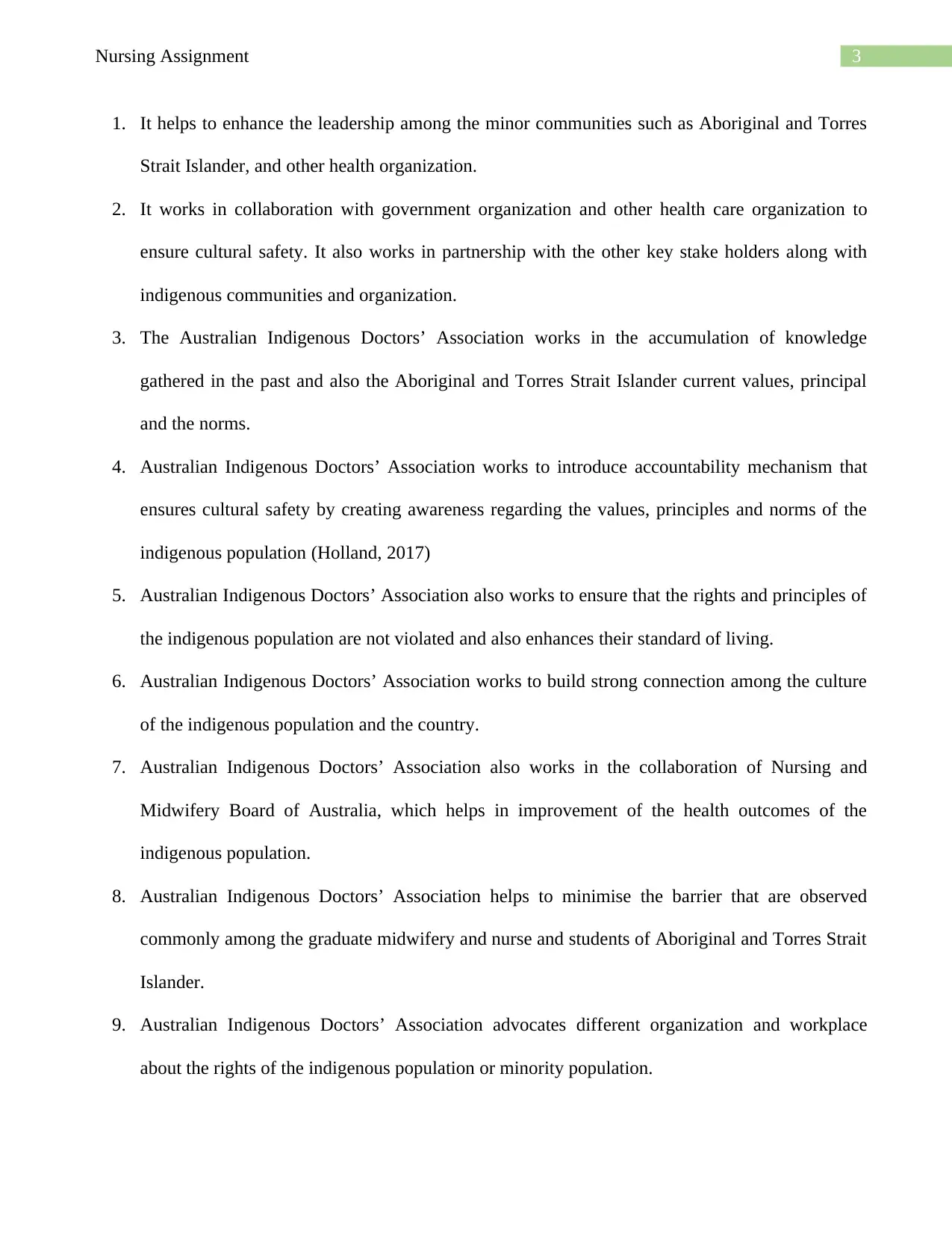
3Nursing Assignment
1. It helps to enhance the leadership among the minor communities such as Aboriginal and Torres
Strait Islander, and other health organization.
2. It works in collaboration with government organization and other health care organization to
ensure cultural safety. It also works in partnership with the other key stake holders along with
indigenous communities and organization.
3. The Australian Indigenous Doctors’ Association works in the accumulation of knowledge
gathered in the past and also the Aboriginal and Torres Strait Islander current values, principal
and the norms.
4. Australian Indigenous Doctors’ Association works to introduce accountability mechanism that
ensures cultural safety by creating awareness regarding the values, principles and norms of the
indigenous population (Holland, 2017)
5. Australian Indigenous Doctors’ Association also works to ensure that the rights and principles of
the indigenous population are not violated and also enhances their standard of living.
6. Australian Indigenous Doctors’ Association works to build strong connection among the culture
of the indigenous population and the country.
7. Australian Indigenous Doctors’ Association also works in the collaboration of Nursing and
Midwifery Board of Australia, which helps in improvement of the health outcomes of the
indigenous population.
8. Australian Indigenous Doctors’ Association helps to minimise the barrier that are observed
commonly among the graduate midwifery and nurse and students of Aboriginal and Torres Strait
Islander.
9. Australian Indigenous Doctors’ Association advocates different organization and workplace
about the rights of the indigenous population or minority population.
1. It helps to enhance the leadership among the minor communities such as Aboriginal and Torres
Strait Islander, and other health organization.
2. It works in collaboration with government organization and other health care organization to
ensure cultural safety. It also works in partnership with the other key stake holders along with
indigenous communities and organization.
3. The Australian Indigenous Doctors’ Association works in the accumulation of knowledge
gathered in the past and also the Aboriginal and Torres Strait Islander current values, principal
and the norms.
4. Australian Indigenous Doctors’ Association works to introduce accountability mechanism that
ensures cultural safety by creating awareness regarding the values, principles and norms of the
indigenous population (Holland, 2017)
5. Australian Indigenous Doctors’ Association also works to ensure that the rights and principles of
the indigenous population are not violated and also enhances their standard of living.
6. Australian Indigenous Doctors’ Association works to build strong connection among the culture
of the indigenous population and the country.
7. Australian Indigenous Doctors’ Association also works in the collaboration of Nursing and
Midwifery Board of Australia, which helps in improvement of the health outcomes of the
indigenous population.
8. Australian Indigenous Doctors’ Association helps to minimise the barrier that are observed
commonly among the graduate midwifery and nurse and students of Aboriginal and Torres Strait
Islander.
9. Australian Indigenous Doctors’ Association advocates different organization and workplace
about the rights of the indigenous population or minority population.
Paraphrase This Document
Need a fresh take? Get an instant paraphrase of this document with our AI Paraphraser
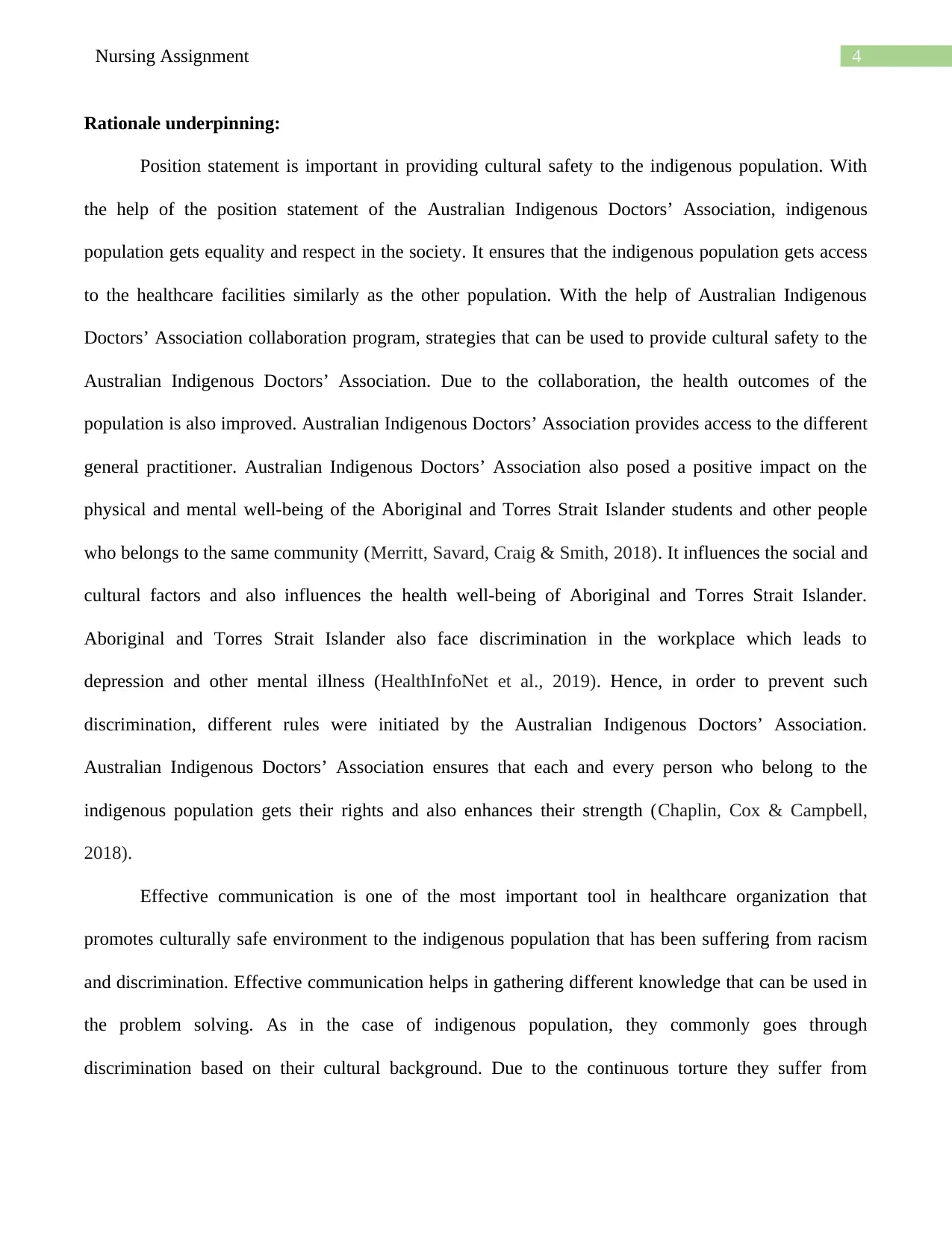
4Nursing Assignment
Rationale underpinning:
Position statement is important in providing cultural safety to the indigenous population. With
the help of the position statement of the Australian Indigenous Doctors’ Association, indigenous
population gets equality and respect in the society. It ensures that the indigenous population gets access
to the healthcare facilities similarly as the other population. With the help of Australian Indigenous
Doctors’ Association collaboration program, strategies that can be used to provide cultural safety to the
Australian Indigenous Doctors’ Association. Due to the collaboration, the health outcomes of the
population is also improved. Australian Indigenous Doctors’ Association provides access to the different
general practitioner. Australian Indigenous Doctors’ Association also posed a positive impact on the
physical and mental well-being of the Aboriginal and Torres Strait Islander students and other people
who belongs to the same community (Merritt, Savard, Craig & Smith, 2018). It influences the social and
cultural factors and also influences the health well-being of Aboriginal and Torres Strait Islander.
Aboriginal and Torres Strait Islander also face discrimination in the workplace which leads to
depression and other mental illness (HealthInfoNet et al., 2019). Hence, in order to prevent such
discrimination, different rules were initiated by the Australian Indigenous Doctors’ Association.
Australian Indigenous Doctors’ Association ensures that each and every person who belong to the
indigenous population gets their rights and also enhances their strength (Chaplin, Cox & Campbell,
2018).
Effective communication is one of the most important tool in healthcare organization that
promotes culturally safe environment to the indigenous population that has been suffering from racism
and discrimination. Effective communication helps in gathering different knowledge that can be used in
the problem solving. As in the case of indigenous population, they commonly goes through
discrimination based on their cultural background. Due to the continuous torture they suffer from
Rationale underpinning:
Position statement is important in providing cultural safety to the indigenous population. With
the help of the position statement of the Australian Indigenous Doctors’ Association, indigenous
population gets equality and respect in the society. It ensures that the indigenous population gets access
to the healthcare facilities similarly as the other population. With the help of Australian Indigenous
Doctors’ Association collaboration program, strategies that can be used to provide cultural safety to the
Australian Indigenous Doctors’ Association. Due to the collaboration, the health outcomes of the
population is also improved. Australian Indigenous Doctors’ Association provides access to the different
general practitioner. Australian Indigenous Doctors’ Association also posed a positive impact on the
physical and mental well-being of the Aboriginal and Torres Strait Islander students and other people
who belongs to the same community (Merritt, Savard, Craig & Smith, 2018). It influences the social and
cultural factors and also influences the health well-being of Aboriginal and Torres Strait Islander.
Aboriginal and Torres Strait Islander also face discrimination in the workplace which leads to
depression and other mental illness (HealthInfoNet et al., 2019). Hence, in order to prevent such
discrimination, different rules were initiated by the Australian Indigenous Doctors’ Association.
Australian Indigenous Doctors’ Association ensures that each and every person who belong to the
indigenous population gets their rights and also enhances their strength (Chaplin, Cox & Campbell,
2018).
Effective communication is one of the most important tool in healthcare organization that
promotes culturally safe environment to the indigenous population that has been suffering from racism
and discrimination. Effective communication helps in gathering different knowledge that can be used in
the problem solving. As in the case of indigenous population, they commonly goes through
discrimination based on their cultural background. Due to the continuous torture they suffer from
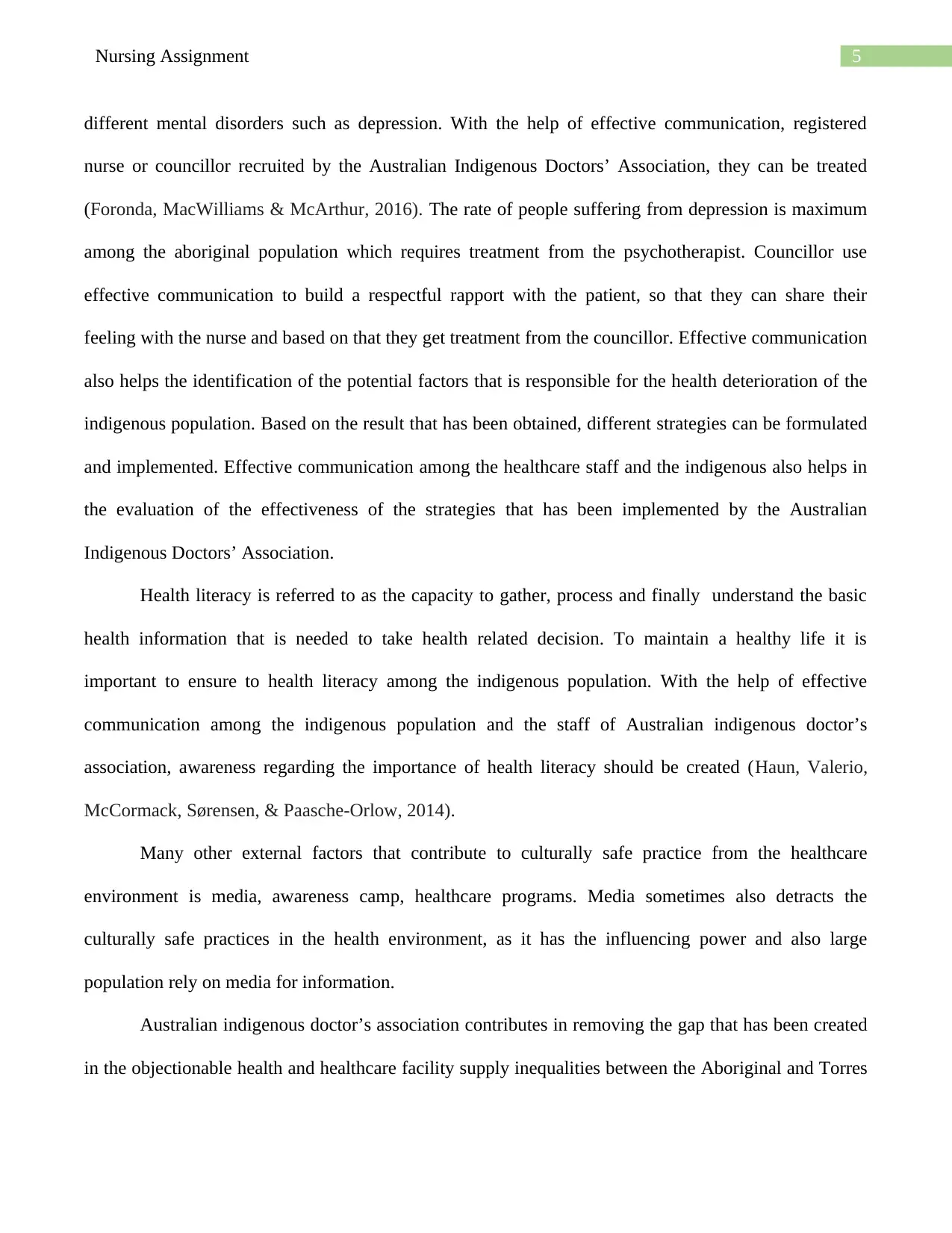
5Nursing Assignment
different mental disorders such as depression. With the help of effective communication, registered
nurse or councillor recruited by the Australian Indigenous Doctors’ Association, they can be treated
(Foronda, MacWilliams & McArthur, 2016). The rate of people suffering from depression is maximum
among the aboriginal population which requires treatment from the psychotherapist. Councillor use
effective communication to build a respectful rapport with the patient, so that they can share their
feeling with the nurse and based on that they get treatment from the councillor. Effective communication
also helps the identification of the potential factors that is responsible for the health deterioration of the
indigenous population. Based on the result that has been obtained, different strategies can be formulated
and implemented. Effective communication among the healthcare staff and the indigenous also helps in
the evaluation of the effectiveness of the strategies that has been implemented by the Australian
Indigenous Doctors’ Association.
Health literacy is referred to as the capacity to gather, process and finally understand the basic
health information that is needed to take health related decision. To maintain a healthy life it is
important to ensure to health literacy among the indigenous population. With the help of effective
communication among the indigenous population and the staff of Australian indigenous doctor’s
association, awareness regarding the importance of health literacy should be created (Haun, Valerio,
McCormack, Sørensen, & Paasche-Orlow, 2014).
Many other external factors that contribute to culturally safe practice from the healthcare
environment is media, awareness camp, healthcare programs. Media sometimes also detracts the
culturally safe practices in the health environment, as it has the influencing power and also large
population rely on media for information.
Australian indigenous doctor’s association contributes in removing the gap that has been created
in the objectionable health and healthcare facility supply inequalities between the Aboriginal and Torres
different mental disorders such as depression. With the help of effective communication, registered
nurse or councillor recruited by the Australian Indigenous Doctors’ Association, they can be treated
(Foronda, MacWilliams & McArthur, 2016). The rate of people suffering from depression is maximum
among the aboriginal population which requires treatment from the psychotherapist. Councillor use
effective communication to build a respectful rapport with the patient, so that they can share their
feeling with the nurse and based on that they get treatment from the councillor. Effective communication
also helps the identification of the potential factors that is responsible for the health deterioration of the
indigenous population. Based on the result that has been obtained, different strategies can be formulated
and implemented. Effective communication among the healthcare staff and the indigenous also helps in
the evaluation of the effectiveness of the strategies that has been implemented by the Australian
Indigenous Doctors’ Association.
Health literacy is referred to as the capacity to gather, process and finally understand the basic
health information that is needed to take health related decision. To maintain a healthy life it is
important to ensure to health literacy among the indigenous population. With the help of effective
communication among the indigenous population and the staff of Australian indigenous doctor’s
association, awareness regarding the importance of health literacy should be created (Haun, Valerio,
McCormack, Sørensen, & Paasche-Orlow, 2014).
Many other external factors that contribute to culturally safe practice from the healthcare
environment is media, awareness camp, healthcare programs. Media sometimes also detracts the
culturally safe practices in the health environment, as it has the influencing power and also large
population rely on media for information.
Australian indigenous doctor’s association contributes in removing the gap that has been created
in the objectionable health and healthcare facility supply inequalities between the Aboriginal and Torres
⊘ This is a preview!⊘
Do you want full access?
Subscribe today to unlock all pages.

Trusted by 1+ million students worldwide

6Nursing Assignment
Strait Islander societies and the non-Indigenous Australian populations. These communities have been
witnessing inequalities since a long period of time, which has been the major reason behind the rise of
mortality and morbidity cases in these populations (Merritt, Savard, Craig & Smith, 2018). The
Australian indigenous doctor’s association has come up with a commencement named as “Close the Gap
Campaign for Indigenous Health Equality” which conducts campaigns and provides facilities to the
target populations in order to solve the difficulties and remove inequalities faced by them.
There are few barriers that have been effecting the implementation of the position statement as
these target regions are found to be lacking education and employment in huge manner. Education plays
a major role in a population to keep them updated and informed regarding the facilities and the laws that
has been provided to them by the government and the healthcare organization. The employment is also a
factor which has been keeping these communities deprived from every facility they have been granted
with. The lack of income and cost of treatment has been the reason behind their deprived lifestyle and
health condition. the ethical view point and the values of these communities also plays a role in avoiding
their implementation, as for these communities their ethical values and ancient believes are above every
idea and knowledge. They don’t keep a mind-set of upgrading their view point and these orthodox mind-
set has also been the reason behind the difficulties they face (Conraads et al., 2016). In order to develop,
The Australian indigenous doctor’s association needs to provide proper knowledge and education to
these populations and educate them regarding their facilities and benefits.
Conclusion:
From the above essay, it can be concluded that, indigenous population are one of the most
vulnerable population. They face discrimination and racism everywhere. Aboriginal individual have
poor health outcomes as compared with the other communities. The rate of mental illness is maximum
in case of Aboriginal and Torres Strait Islander. To reduce such adverse effect, Australian Indigenous
Strait Islander societies and the non-Indigenous Australian populations. These communities have been
witnessing inequalities since a long period of time, which has been the major reason behind the rise of
mortality and morbidity cases in these populations (Merritt, Savard, Craig & Smith, 2018). The
Australian indigenous doctor’s association has come up with a commencement named as “Close the Gap
Campaign for Indigenous Health Equality” which conducts campaigns and provides facilities to the
target populations in order to solve the difficulties and remove inequalities faced by them.
There are few barriers that have been effecting the implementation of the position statement as
these target regions are found to be lacking education and employment in huge manner. Education plays
a major role in a population to keep them updated and informed regarding the facilities and the laws that
has been provided to them by the government and the healthcare organization. The employment is also a
factor which has been keeping these communities deprived from every facility they have been granted
with. The lack of income and cost of treatment has been the reason behind their deprived lifestyle and
health condition. the ethical view point and the values of these communities also plays a role in avoiding
their implementation, as for these communities their ethical values and ancient believes are above every
idea and knowledge. They don’t keep a mind-set of upgrading their view point and these orthodox mind-
set has also been the reason behind the difficulties they face (Conraads et al., 2016). In order to develop,
The Australian indigenous doctor’s association needs to provide proper knowledge and education to
these populations and educate them regarding their facilities and benefits.
Conclusion:
From the above essay, it can be concluded that, indigenous population are one of the most
vulnerable population. They face discrimination and racism everywhere. Aboriginal individual have
poor health outcomes as compared with the other communities. The rate of mental illness is maximum
in case of Aboriginal and Torres Strait Islander. To reduce such adverse effect, Australian Indigenous
Paraphrase This Document
Need a fresh take? Get an instant paraphrase of this document with our AI Paraphraser
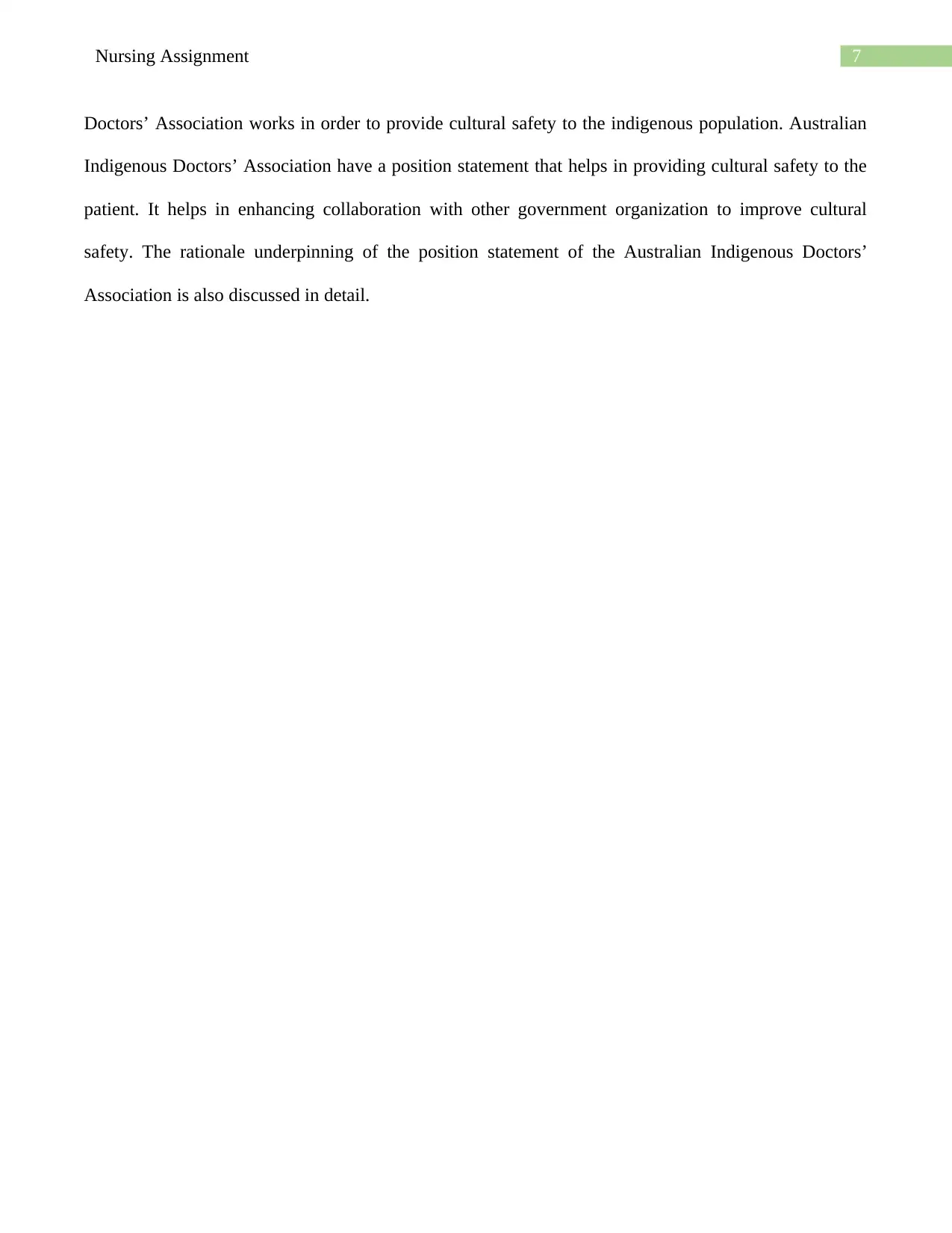
7Nursing Assignment
Doctors’ Association works in order to provide cultural safety to the indigenous population. Australian
Indigenous Doctors’ Association have a position statement that helps in providing cultural safety to the
patient. It helps in enhancing collaboration with other government organization to improve cultural
safety. The rationale underpinning of the position statement of the Australian Indigenous Doctors’
Association is also discussed in detail.
Doctors’ Association works in order to provide cultural safety to the indigenous population. Australian
Indigenous Doctors’ Association have a position statement that helps in providing cultural safety to the
patient. It helps in enhancing collaboration with other government organization to improve cultural
safety. The rationale underpinning of the position statement of the Australian Indigenous Doctors’
Association is also discussed in detail.
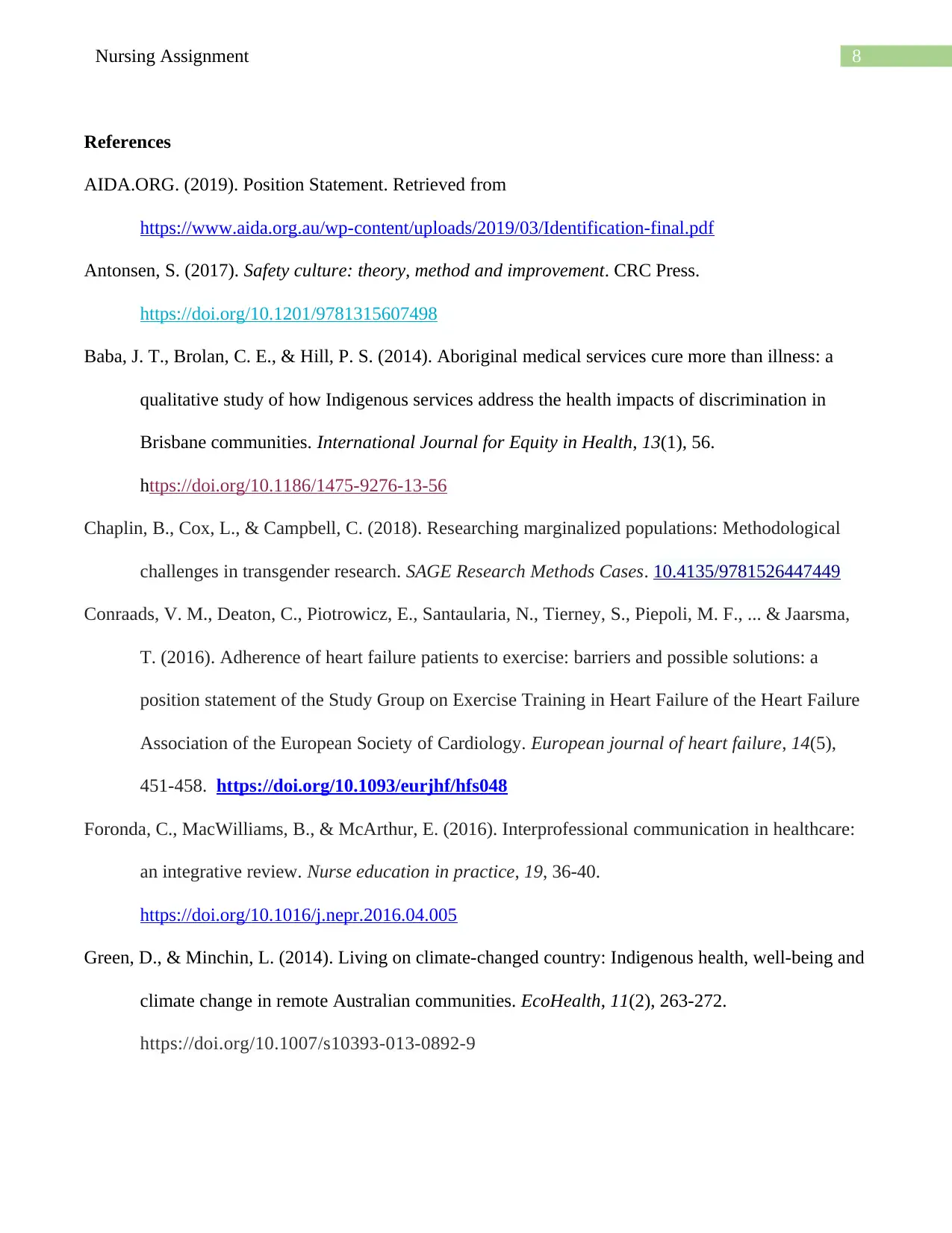
8Nursing Assignment
References
AIDA.ORG. (2019). Position Statement. Retrieved from
https://www.aida.org.au/wp-content/uploads/2019/03/Identification-final.pdf
Antonsen, S. (2017). Safety culture: theory, method and improvement. CRC Press.
https://doi.org/10.1201/9781315607498
Baba, J. T., Brolan, C. E., & Hill, P. S. (2014). Aboriginal medical services cure more than illness: a
qualitative study of how Indigenous services address the health impacts of discrimination in
Brisbane communities. International Journal for Equity in Health, 13(1), 56.
https://doi.org/10.1186/1475-9276-13-56
Chaplin, B., Cox, L., & Campbell, C. (2018). Researching marginalized populations: Methodological
challenges in transgender research. SAGE Research Methods Cases. 10.4135/9781526447449
Conraads, V. M., Deaton, C., Piotrowicz, E., Santaularia, N., Tierney, S., Piepoli, M. F., ... & Jaarsma,
T. (2016). Adherence of heart failure patients to exercise: barriers and possible solutions: a
position statement of the Study Group on Exercise Training in Heart Failure of the Heart Failure
Association of the European Society of Cardiology. European journal of heart failure, 14(5),
451-458. https://doi.org/10.1093/eurjhf/hfs048
Foronda, C., MacWilliams, B., & McArthur, E. (2016). Interprofessional communication in healthcare:
an integrative review. Nurse education in practice, 19, 36-40.
https://doi.org/10.1016/j.nepr.2016.04.005
Green, D., & Minchin, L. (2014). Living on climate-changed country: Indigenous health, well-being and
climate change in remote Australian communities. EcoHealth, 11(2), 263-272.
https://doi.org/10.1007/s10393-013-0892-9
References
AIDA.ORG. (2019). Position Statement. Retrieved from
https://www.aida.org.au/wp-content/uploads/2019/03/Identification-final.pdf
Antonsen, S. (2017). Safety culture: theory, method and improvement. CRC Press.
https://doi.org/10.1201/9781315607498
Baba, J. T., Brolan, C. E., & Hill, P. S. (2014). Aboriginal medical services cure more than illness: a
qualitative study of how Indigenous services address the health impacts of discrimination in
Brisbane communities. International Journal for Equity in Health, 13(1), 56.
https://doi.org/10.1186/1475-9276-13-56
Chaplin, B., Cox, L., & Campbell, C. (2018). Researching marginalized populations: Methodological
challenges in transgender research. SAGE Research Methods Cases. 10.4135/9781526447449
Conraads, V. M., Deaton, C., Piotrowicz, E., Santaularia, N., Tierney, S., Piepoli, M. F., ... & Jaarsma,
T. (2016). Adherence of heart failure patients to exercise: barriers and possible solutions: a
position statement of the Study Group on Exercise Training in Heart Failure of the Heart Failure
Association of the European Society of Cardiology. European journal of heart failure, 14(5),
451-458. https://doi.org/10.1093/eurjhf/hfs048
Foronda, C., MacWilliams, B., & McArthur, E. (2016). Interprofessional communication in healthcare:
an integrative review. Nurse education in practice, 19, 36-40.
https://doi.org/10.1016/j.nepr.2016.04.005
Green, D., & Minchin, L. (2014). Living on climate-changed country: Indigenous health, well-being and
climate change in remote Australian communities. EcoHealth, 11(2), 263-272.
https://doi.org/10.1007/s10393-013-0892-9
⊘ This is a preview!⊘
Do you want full access?
Subscribe today to unlock all pages.

Trusted by 1+ million students worldwide
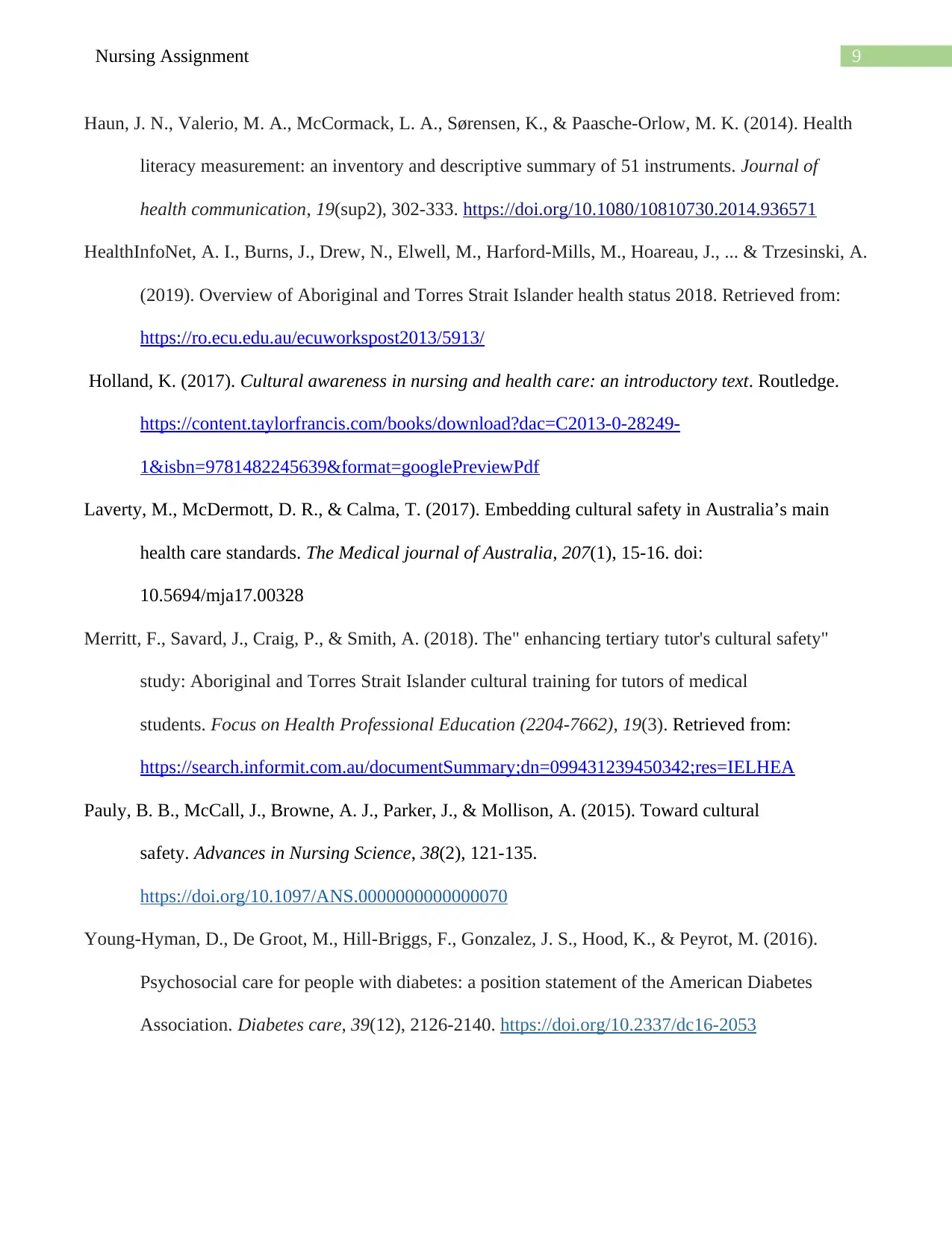
9Nursing Assignment
Haun, J. N., Valerio, M. A., McCormack, L. A., Sørensen, K., & Paasche-Orlow, M. K. (2014). Health
literacy measurement: an inventory and descriptive summary of 51 instruments. Journal of
health communication, 19(sup2), 302-333. https://doi.org/10.1080/10810730.2014.936571
HealthInfoNet, A. I., Burns, J., Drew, N., Elwell, M., Harford-Mills, M., Hoareau, J., ... & Trzesinski, A.
(2019). Overview of Aboriginal and Torres Strait Islander health status 2018. Retrieved from:
https://ro.ecu.edu.au/ecuworkspost2013/5913/
Holland, K. (2017). Cultural awareness in nursing and health care: an introductory text. Routledge.
https://content.taylorfrancis.com/books/download?dac=C2013-0-28249-
1&isbn=9781482245639&format=googlePreviewPdf
Laverty, M., McDermott, D. R., & Calma, T. (2017). Embedding cultural safety in Australia’s main
health care standards. The Medical journal of Australia, 207(1), 15-16. doi:
10.5694/mja17.00328
Merritt, F., Savard, J., Craig, P., & Smith, A. (2018). The" enhancing tertiary tutor's cultural safety"
study: Aboriginal and Torres Strait Islander cultural training for tutors of medical
students. Focus on Health Professional Education (2204-7662), 19(3). Retrieved from:
https://search.informit.com.au/documentSummary;dn=099431239450342;res=IELHEA
Pauly, B. B., McCall, J., Browne, A. J., Parker, J., & Mollison, A. (2015). Toward cultural
safety. Advances in Nursing Science, 38(2), 121-135.
https://doi.org/10.1097/ANS.0000000000000070
Young-Hyman, D., De Groot, M., Hill-Briggs, F., Gonzalez, J. S., Hood, K., & Peyrot, M. (2016).
Psychosocial care for people with diabetes: a position statement of the American Diabetes
Association. Diabetes care, 39(12), 2126-2140. https://doi.org/10.2337/dc16-2053
Haun, J. N., Valerio, M. A., McCormack, L. A., Sørensen, K., & Paasche-Orlow, M. K. (2014). Health
literacy measurement: an inventory and descriptive summary of 51 instruments. Journal of
health communication, 19(sup2), 302-333. https://doi.org/10.1080/10810730.2014.936571
HealthInfoNet, A. I., Burns, J., Drew, N., Elwell, M., Harford-Mills, M., Hoareau, J., ... & Trzesinski, A.
(2019). Overview of Aboriginal and Torres Strait Islander health status 2018. Retrieved from:
https://ro.ecu.edu.au/ecuworkspost2013/5913/
Holland, K. (2017). Cultural awareness in nursing and health care: an introductory text. Routledge.
https://content.taylorfrancis.com/books/download?dac=C2013-0-28249-
1&isbn=9781482245639&format=googlePreviewPdf
Laverty, M., McDermott, D. R., & Calma, T. (2017). Embedding cultural safety in Australia’s main
health care standards. The Medical journal of Australia, 207(1), 15-16. doi:
10.5694/mja17.00328
Merritt, F., Savard, J., Craig, P., & Smith, A. (2018). The" enhancing tertiary tutor's cultural safety"
study: Aboriginal and Torres Strait Islander cultural training for tutors of medical
students. Focus on Health Professional Education (2204-7662), 19(3). Retrieved from:
https://search.informit.com.au/documentSummary;dn=099431239450342;res=IELHEA
Pauly, B. B., McCall, J., Browne, A. J., Parker, J., & Mollison, A. (2015). Toward cultural
safety. Advances in Nursing Science, 38(2), 121-135.
https://doi.org/10.1097/ANS.0000000000000070
Young-Hyman, D., De Groot, M., Hill-Briggs, F., Gonzalez, J. S., Hood, K., & Peyrot, M. (2016).
Psychosocial care for people with diabetes: a position statement of the American Diabetes
Association. Diabetes care, 39(12), 2126-2140. https://doi.org/10.2337/dc16-2053
1 out of 10
Related Documents
Your All-in-One AI-Powered Toolkit for Academic Success.
+13062052269
info@desklib.com
Available 24*7 on WhatsApp / Email
![[object Object]](/_next/static/media/star-bottom.7253800d.svg)
Unlock your academic potential
Copyright © 2020–2025 A2Z Services. All Rights Reserved. Developed and managed by ZUCOL.





